| Srl | Item |
| 1 |
ID:
081481


|
|
|
|
|
| Publication |
2008.
|
| Summary/Abstract |
Economic globalisation, coupled with geopolitical instability and international terrorism, has made it impossible for any single country to secure its energy supply entirely on its own. The urgent energy security issue has resulted in brisk energy diplomacy with aspirations for cooperation running high among both producing and consuming countries. The concept of energy security needs to be expanded, however, because the real risks are not 'below ground' (a lack of resources) but 'above ground' (political instability). We need a new energy security concept to ensure global energy security. India and China can take the lead by finding ways to cooperate on energy rather than taking adversarial positions. The article reasons that with clearer identification of shared interests, China and India together can help strengthen Asian unity, stability and prosperity and thus significantly contribute to the world order
|
|
|
|
|
|
|
|
|
|
|
|
|
|
|
|
| 2 |
ID:
081484
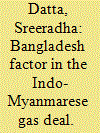

|
|
|
|
|
| Publication |
2008.
|
| Summary/Abstract |
With the discovery of substantial gas in Myanmar's Sittwe region in the Rakhine state, India was keen to acquire gas from some of the new finds in the Shwe gas field, divided in several blocks, of which A-1 and A-2 blocks were closer to India and also estimated to have the best recoverable reserves. Given the geographical location, overland pipelines transiting through Bangladesh are the most cost-effective way of getting gas from Myanmar to India. Despite its initial enthusiasm, Bangladesh backtracked from its earlier willingness to be a partner to the tripartite pipeline. Dhaka tied its support for the project to India accepting its many existing demands in other area. The domestic opposition in Bangladesh delayed the finalising of the pipeline routes-one of the main reasons that eventually led to other countries walking away with the contract of the A-1 block
|
|
|
|
|
|
|
|
|
|
|
|
|
|
|
|
| 3 |
ID:
081480
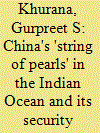

|
|
|
|
|
| Publication |
2008.
|
| Summary/Abstract |
China's efforts to build 'nodes' of influence in the Indian Ocean Region have been increasingly discernible in recent years. This endeavour, many argue, is driven by Beijing's military-strategic ends. However, such an argument remains a speculation, backed by frail and somewhat disjointed evidence. At least in the public domain, it may be too early to marshal tangible evidence to prove or dismiss the hypothesis. An assessment is nonetheless crucial because notwithstanding China's legitimate interests in the Indian Ocean, its naval presence in these waters would bear strongly upon the security calculi of India in particular and those of other major powers. From the study of available information, this paper attempts to derive China's objectives in the Indian Ocean, its approach and the attendant security ramifications for India
|
|
|
|
|
|
|
|
|
|
|
|
|
|
|
|
| 4 |
ID:
081483
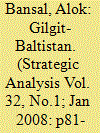

|
|
|
|
|
| Publication |
2008.
|
| Summary/Abstract |
Gilgit-Baltistan in Pakistan-Occupied Kashmir has witnessed a series of political disturbances and violence over the past years. Though many analysts have viewed the often-violent assertions by otherwise peaceful residents of this remote and mountainous region as occasional eruptions of the Shia-Sunni sectarian divide, a careful examination will indicate the deeper roots of alienation of the population in this long-neglected region. Almost total absence of democratic rights, lack of participation in the government and economic exploitation of the region coupled with ethnic, cultural and linguistic marginalisation appear to be the main factors that have led to this alienation.
|
|
|
|
|
|
|
|
|
|
|
|
|
|
|
|
| 5 |
ID:
081487
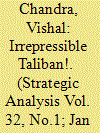

|
|
|
| 6 |
ID:
081485
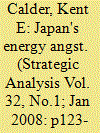

|
|
|
| 7 |
ID:
081486


|
|
|
| 8 |
ID:
081482


|
|
|
|
|
| Publication |
2008.
|
| Summary/Abstract |
The Sunni Muslims of South Asia are divided into two major sub-sects, i.e. Deobandi and Barelvi, named after their places of origin in India in the 19th century. Because of abiding differences between them, these two sub-sects have built up walls of hatred and mistrust between them over time. The faultline between them has erupted violently in Pakistan since the late 1970s. While there are some pioneering works available on their separate worldviews, no study has yet been attempted to critically analyse the nature of their interaction at the political level. This article discusses the pattern of interaction between the sub-sects since the colonial days, during the movement for Partition, and later in Pakistani politics
|
|
|
|
|
|
|
|
|
|
|
|
|
|
|
|